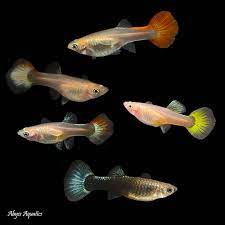Guppy-Female
Guppy-Female
check_circle Fast Shipping
check_circle Quality Products
check_circle Affordable Price
Reach out to us on ''available to order'' items via WhatsApp or email
30 in stock
Couldn't load pickup availability

Guppy-Female
package_2
Product Description
Product Description
All our fish, shrimp and corals are bagged with fresh oxygen as well as a heat pack in winter.
When ordering livestock please select the box size and add it to your cart for accurate overnight (1-2 days) shipping costs. A small box can take 1-2 bags and a medium box 6 bags. One bag fits max 10 small (1-3cm) fish or max 2 medium (3-5cm) fish or max 1 large (>5cm) fish.
ONE SPECIES PER BAG. Eg: One bag of 10 neon tetra.
Guppy (Poecilia reticulata)
Description:
-
Appearance:
- Body: Small, colorful fish with a torpedo-shaped body.
- Color: Highly variable; males are particularly known for their vibrant colors and intricate patterns, which can include shades of red, blue, green, yellow, and more. Females are generally less colorful and larger.
- Size: Males typically grow to about 1.5-2.5 inches (3.8-6.4 cm); females are larger, reaching up to 2.5-3 inches (6.4-7.6 cm).
- Distinctive Feature: Males have a gonopodium (modified anal fin) used for reproduction, and their coloration is more vivid compared to females.
-
Behavior:
- Activity: Active and lively swimmers, often seen darting around the tank.
- Social Structure: Peaceful and sociable, thriving in groups. They do well in community tanks with other small, non-aggressive fish.
Care Requirements:
-
Tank Size:
- Minimum: 10 gallons (38 liters) for a small group. Larger tanks are preferable to provide ample swimming space and reduce stress.
-
Water Parameters:
- Temperature: 74-78°F (23-25°C). They thrive in warm water but can tolerate a range of temperatures.
- pH: 6.8-7.8. Slightly alkaline to neutral water is ideal.
- Hardness: Soft to moderately hard water.
- Filtration: Moderate filtration is adequate. Ensure the tank has good water circulation but avoid strong currents which may stress the fish.
-
Tank Setup:
- Substrate: Gravel or sand. Smooth substrate is best to avoid damage to their delicate fins.
- Aquascaping: Provide plenty of hiding spots and cover with live plants, rocks, and driftwood. They enjoy having places to explore and hide.
- Lighting: Moderate lighting is acceptable. Maintain a regular light/dark cycle to mimic natural conditions.
-
Diet:
- Primary Food: Omnivorous; feed high-quality flakes or pellets formulated for small tropical fish.
- Supplemental Food: Offer occasional live or frozen foods such as brine shrimp, daphnia, and bloodworms to provide variety and enhance their color.
-
Behavioral Considerations:
- Compatibility: Guppies are peaceful and can be kept with other small, non-aggressive species. They are often used as a part of a community tank with species like tetras, mollies, and platies.
- Social Behavior: Prefer to be kept in groups (at least 6-8) to feel secure and display natural behaviors. Avoid keeping only one sex unless you want to limit breeding.
-
Tank Maintenance:
- Water Changes: Regular water changes (20-30% weekly) are crucial to maintain water quality and remove excess waste.
- Cleaning: Clean the tank regularly, removing uneaten food and detritus. Check the filtration system to ensure it is functioning well.
-
Health Care:
- Observation: Monitor for signs of stress or illness, such as changes in behavior, loss of appetite, or visible symptoms like discoloration or lesions.
- Treatment: Maintain good water quality and consult an aquarium professional if health issues arise. Common problems include fin rot and ich. Early detection and treatment are key to preventing serious issues.


